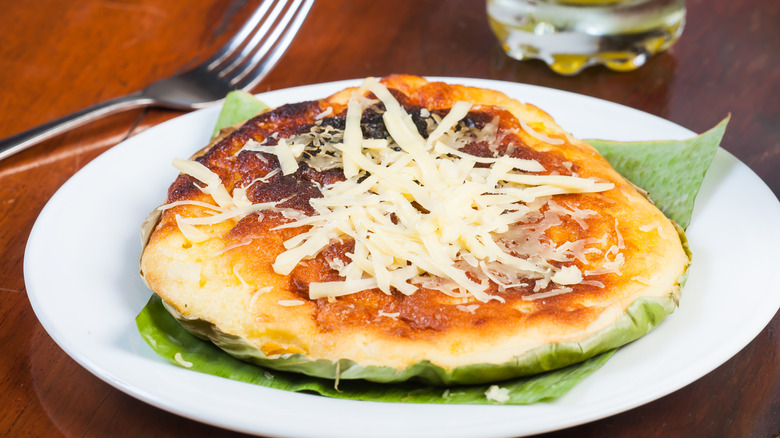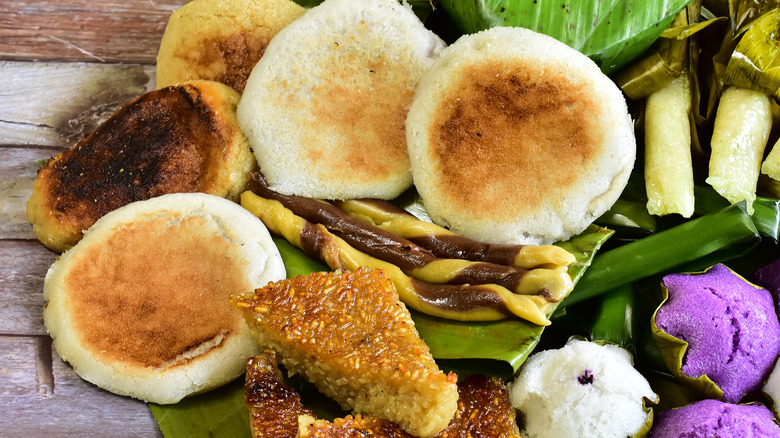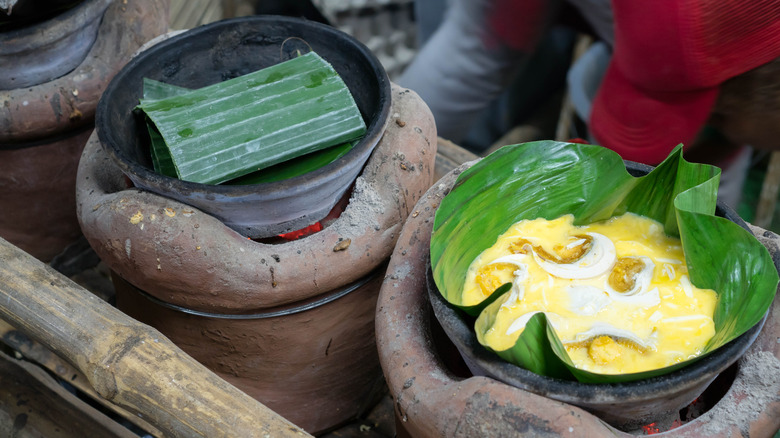Bibingka: The Festive Filipino Cake That Pairs Sweet With Salty
The Philippines has a passionate and enduring love affair with Christmas, which is why the festive season kicks off at the start of what it calls the "-ber" months — September, October, November, and December — making it the longest Christmas season in the world (per Bria). But no matter when this period begins in malls and stores, the Catholic country's religious observance begins nine days before the day itself — when the faithful go to mass every morning at dawn for services known as Simbang Gabi or "night masses" (via foodpanda). The rewards are great for those who get up early to make their way to church, and these come in the form of hot, freshly-made, traditional Christmas rice cakes: bibingka.
While bibingka can be bought from specialty restaurants and enjoyed any time of year, they hit a different spot when they are enjoyed during the lead-up to the holidays. No one knows when or how they became part of the Philippines' Christmas food tradition — or who even started making the cakes, to begin with — but SBS points to an 18th-century priest named Juan Delgado, who started his day with a serving of what he called "bibinca" and chocolate.
There are many different varieties of bibingka
While every Filipino will probably remember enjoying bibingka made a particular way, Yummy says there are at least five different methods to prepare this treat. The most popular variety is made with "galapong" or rice flour, which is created by soaking rice overnight and then grinding it up with a mortar, per SBS; today, making these cakes with a mix of rice flour and glutinous rice flour will do the trick. Once it is cooked, the bibingka can be topped with various ingredients, including cheese, butter, coconut, brown sugar, or even salted egg, per Yummy.
Another type of bibingka, known as "bibingka malagkit" or "biko," can also be made by mixing glutinous rice and coconut milk and topping that with a coconut cream topping. "Bibingkang kamoteng kahoy" (cassava cake) is made with cassava flour or grated cassava root and finished with a mixture of milk and grated cheese, according to Yummy.
There are also specialty bibingka which can only be found in a specific region. "Balasan-style bibingka," which is white and dense and baked with strips of young coconut, can only be found in one area in the central Philippine city of Iloilo, per I Love Iloilo. Another regional bibingka is "bibingkoy," made in northern Cavite. Here, the treat is made dumpling-style, filled with red bean paste, and served with a coconut cream sauce flavored with jackfruit and thickened with sago, per YouTube.
How bibingka is made
According to Ang Sarap, bibingka is traditionally made in a clay pot lined with banana leaves and left to bake in a contraption fired by hot coals placed directly on top and underneath. Although, those who want to try the recipe at home can use a regular oven to make this tasty delicacy. And while it might look like an option, using banana leaves to make your bibingka will enhance the cake's flavor, and SBS suggests warming the leaves over a candle or gas stove so they become soft and easy to work with.
To make this rice cake, SBS calls for a dough made with a mix of rice flour and glutinous rice flour, baking powder, sugar, melted butter, coconut milk, and eggs, although Panlasang Pinoy leaves out the glutinous rice flour. However, both methods call for the batter to be cooked halfway, or about 15 minutes, before adding whatever toppings you might want to add — cheese and salted egg are recommended — before returning the cakes to the oven to finish. Smother them with melted butter and add pinches of grated coconut before serving. If you want to make bibingka the old-fashioned way using a rice batter made with glutinous rice, The Quirino Kitchen offers this method, too.
Once made, bibingka can be frozen and thawed before it is heated in an oven, so if you're from the Philippines but live far away, making bibingka could tide you over until the next time you make it back.


